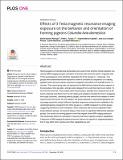Effects of 3 Tesla magnetic resonance imaging exposure on the behavior and orientation of homing pigeons Columba livia domestica
Abstract
Homing pigeons (Columba livia domestica) were used to test whether clinical magnetic resonance (MR) imaging disrupts orientation of animals that sense the earth’s magnetic field. Thirty young pigeons were randomly separated into three groups (n = 10/group). Two groups were anaesthetized and exposed to either a constant (no sequence) or a varying (gradient echo and echo planar sequences) magnetic field within a 3 Tesla MR unit for 15 minutes. The control group was not exposed to the MR field but shared all other aspects of the procedure. One day later, animals were released from a site they had never visited, 15 km from the home loft. Three weeks after the procedure, animals were released from a different unfamiliar site 30 km from the loft. Measured variables included the time to disappear from sight (seconds), vanishing bearing (angle), and the time interval from release to entering the home loft (hours). On first release, the group exposed to varying field gradients during image acquisition using 2 different standard sequences showed more variability in the vanishing bearing compared to the other groups (p = 0.0003 compared to control group), suggesting interference with orientation. Other measures did not show significant differences between groups. On second release, there were no significant differences between groups. Our results on homing pigeons show that regular clinical MR imaging exposure may temporarily affect the orientation of species that have magnetoreception capabilities. If exposure to MR imaging disrupted processes that are not specific to magnetoreception, then it may affect other species and other capabilities as well.
Citation
Párraga , D G , Tyack , P L , Marco-Cabedo , V , Crespo-Picazo , J L , Manteca , X & Martí-Bonmatí , L 2020 , ' Effects of 3 Tesla magnetic resonance imaging exposure on the behavior and orientation of homing pigeons Columba livia domestica ' , PLoS ONE , vol. 15 , no. 12 , e0241280 . https://doi.org/10.1371/journal.pone.0241280
Publication
PLoS ONE
Status
Peer reviewed
ISSN
1932-6203Type
Journal article
Description
Funding: PLT was funded by the US Office of Naval Research (https://www.onr.navy.mil) Grant Number N00014-18-1-2062 and N00014-20-1-2709. The employees of the Fundación Oceanogràfic de la Comunidad Valenciana were funded by the Fundación.Collections
Items in the St Andrews Research Repository are protected by copyright, with all rights reserved, unless otherwise indicated.

